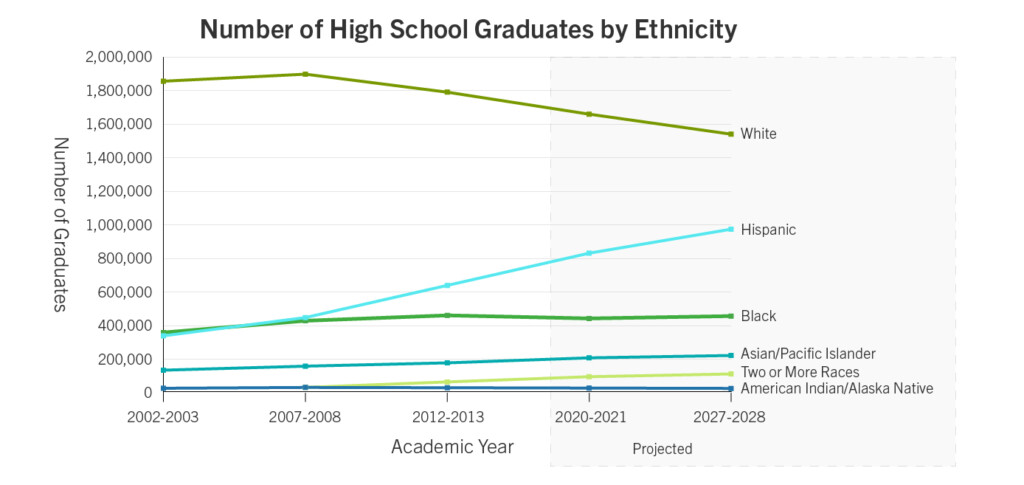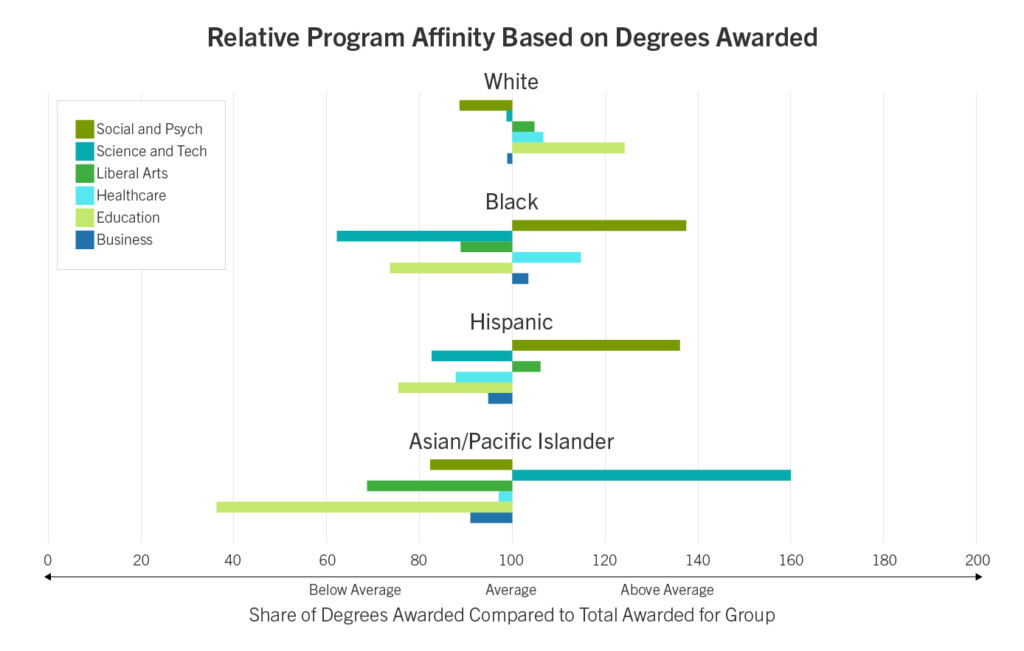
Student Demographics Are Changing: Here’s What Colleges Need to Know About It
It’s fair to say that students still value higher education. Total college enrollment has hovered around 20 million students since 2013, and the National Center for Education Statistics (NCES) expects that to remain true in the coming years. But the nature of enrollment is shifting.
Consider how greater access to flexible learning has opened the door to those who aren’t able to commit to being a full-time student. About 38 percent of undergraduate students and 43 percent of graduate students are enrolled part time. And a handful of mega-universities are garnering an ever-larger portion of the market share, driven in part by their emphasis on part-time adult students.
It’s also worth mentioning that the student body itself is changing. Tomorrow’s college attendees are expected to be far more diverse than today’s.
All this is to say a business-as-usual mindset isn’t going to work going forward, because the higher education landscape is rapidly changing. Terri Nierengarten, senior director of academic solutions at Collegis Education, thinks colleges are already aware of how their future student body will shift.
“I think everybody acknowledges that the demographics are changing,” she says. “I don’t think many schools have translated that into what it means in terms of how they may have to change as an institution.”
While there are numerous steps higher education institutions can take to ensure they’re meeting future students’ needs, it’s first important to dig into how the population is changing.
A look at where student demographics are heading
Today’s student body is already different than it was a few decades ago. Projections show an even more diverse future. The U.S. Census Bureau’s population reports estimate that, by 2020, less than half of children under the age of 18 will be non-Hispanic white. By 2060, that number is projected to be less than one-third.
When we look at high school graduates, in particular, 68 percent were white in 2003 compared to a projected 51 percent in 2021. That obviously means there will be growth in the proportion of minority students in the prospective-student pool. The most notable change is for Hispanic students, who are expected to go from 13 percent of high school graduates in 2003 to a projected 25 percent in 2021. And this isn’t a one-off event. These trends are expected to continue well into the future.

*National Center for Education Statistics. Projections of Education Statistics to 2027.
February 2019 report.
Understandably, there are regional differences to take into consideration, as well. U.S. Census Bureau data shows some areas have a higher proportion of certain populations. In the Plains region — Iowa Kansas, Minnesota, Missouri, Nebraska, North Dakota and South Dakota — 72 percent of the population is white while only 9 percent is Hispanic. Compare that to the Southwest — Arizona, New Mexico, Oklahoma and Texas — where 35 percent of the population is white and 42 percent is Hispanic.
It’s important, too, to notice how enrollment among recent high school graduates varies by race and ethnicity. While the percentage of students who enroll in college immediately following high school has grown to 67 percent, recent graduates who are black or Hispanic fall short of that number.
And, when considering those students who start college as adults or have otherwise experienced some sort of education gap, it’s important to remember that they also have different needs based on that experience. Consider, for example, that some adult students may have families and be working full time.
“There’s a big difference in a student whose path goes directly from high school into college and someone who has a break,” Nierengarten points out. “Schools that do a good job of recognizing that break — whether it be through effective onboarding of new students, transfer credit policies, or lifestyle friendly learning options — will find they are at an advantage to serving this audience.”
Given these changes from the primarily white, just-out-of-high-school demographics of the past, it’s vital that institutions consider these factors in regards to learning support, marketing strategies and flexible delivery models.
Changing demographics mean changing perspectives
As the student population becomes more diverse, it’s important to recognize that race and ethnicity can significantly affect your prospective students’ experiences and overall mindset. Pew Research Center’s “Races in America 2019” survey found significant differences in how a person’s race affects their life. Key highlights from this report include:
- 52 percent of black individuals say their race has hurt their ability to get ahead.
- 45 percent of white individuals say their race has helped their ability to get ahead.
- Black individuals, followed by Hispanics, are most likely to say people have acted suspicious of them or as if they weren’t smart.
- A majority of both black and Asian individuals say they’ve experienced discrimination.
- 74 percent of black individuals, 59 percent of Hispanic individuals and 56 percent of Asian individuals see their race as central to their identity.
Students don’t simply leave these experiences behind when they enroll in a degree program. Their backgrounds shape their identity, their choices.
One of the most noticeable ways we see varying life experiences play out in the college setting is through program selection. There appear to be preferences among different racial and ethnic populations. The index below illustrates these distinctions by showing how the share of degrees awarded to a particular racial or ethnic group in a given field compares to the average share of total degrees awarded to that group. (Within the following graph, a number higher than 100 is greater than average for that particular ethnic group while a number below 100 is less than average for that group.)

*Digest of Education Statistics, Table 322.30; https://nces.ed.gov
You’ll notice that black and Hispanic students, for example, show a noticeable preference for the social and psychological sciences. And minority students as a whole don’t show strong affinity for studying education-oriented degree programs.
What this means for colleges
Today’s high school students are tomorrow’s college-bound adults. Unlike most segments of the market, higher education institutions have the rare benefit of being able to see who their future consumers will be. We already have a fairly good picture of what college enrollment by ethnicity will look like in the next decade.
But taking action to meet that audience where they are is essential. Colleges need to address, but not pander to, these different audiences. The key is that outreach – and its follow-through – has to be authentic.
“Speak to things like a degree program that will work for more complicated life needs or a degree structure that will meet students wherever they are in their career or learning journey with solutions that accelerate their ability to capitalize on their time at your school,” Nierengarten suggests.
It might sound intimidating, but bear in mind that some institutions are already succeeding in meeting diverse students’ needs. The numbers reflect this if you study them a bit to uncover which types of institutions different groups typically choose for enrollment. Hispanic students have traditionally shown a strong affinity for two-year public schools. And black students have the highest propensity of all ethnicities to enroll in for-profit schools.
Instead of being intimidated by this news, colleges should see this as an opportunity to learn and consider how they can adjust to meet the needs of their future students. At the very least, schools should consider what they can do to remove barriers that contribute to students dropping out. They may need to think about implementing some sort of onboarding program for adult students or considering how degree preferences among different racial and ethnic groups should inform program offerings.
Institutions can also look to adopt tactics like providing more robust support services, such as online office hours, and flexible learning models. Even making it easier for adult students to transfer credits makes a difference.
“That’s a really big deal, especially for someone who may have been in a scenario where they had to stop and then re-start college,” Nierengarten offers.
And remember that the job isn’t done once a student enrolls in a program. Continuing to support those students throughout their entire education journey is essential.
If you’d like help navigating the changing marketplace or evaluating your program offerings, get in touch. You can reach us at info@collegiseducation.com.
Innovation Starts Here
Higher ed is evolving — don’t get left behind. Explore how Collegis can help your institution thrive.